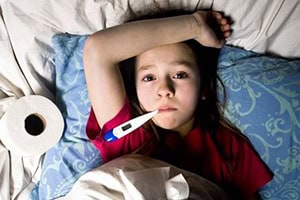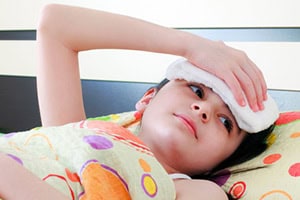Photo credit: GetDocSays
Fever is one of the most common reasons for children to visit the clinic or hospital. Fever itself is not an illness, and is not a diagnosis. Rather, it is a sign or symptom of sickness. Fever is a sign that the body’s defense system is trying to fight an infection, by enhancing the immune response towards the infection.
Besides infection, fever can be due to less common conditions such as autoimmune conditions (SLE, rheumatoid arthritis), inflammatory diseases (Kawasaki disease) and also malignancy (leukemia).
Temperature is the measurement of the degree of fever. It will vary with age, activity and time of day. Everyone has his or her own internal “thermostat” (hypothalamus in the brain) that regulates body temperature. A normal body temperature is around 98.6°F plus or minus about 1°F (37°C, plus or minus about 0.6°C). Fever is a result of the changes in the hypothalamic “thermostat” set-point, due to the conditions mentioned earlier. Generally, fever of less than 40.5°C is in itself not harmful, only if the level is above 41 to 42°C (called hyperpyrexia) will it have adverse physiological effects.

Photo credit: express.co.uk
Rectal temperatures are the ‘gold standard’ for measuring central body temperature. But more common types of temperature measurement are from ear, mouth and armpit. You can get the fastest and most accurate results with a digital thermometer, which has a sensor on the end of the thermometer that touches the body part and reads the body temperature, either oral, ear, armpit or rectal.
There are many types of infections that can cause fever in children, but the most common one is viral fever caused by a viral infection, examples are roseola, dengue fever, measles, chickenpox and hand-foot-mouth disease. Generally, there are no specific treatment for viral infections, in other words, antibiotic treatment has no role in viral fever. The fever can be high for 3 to 4 days initially and can last up to a week or more. There is no evidence that high fever by itself will lead to “brain damage”. But a viral fever can be potentially serious if the affected child has constitutional complaints such as poor feeding or vomiting, difficulty in breathing, drowsiness or irritability.

Photo credit: healthdirect.gov.au
There are 2 ways of managing fever in children, either by taking medications (for example Paracetamol) or non-medicinal way by tepid sponging using tap or lukewarm water. Fever generally does not need to be treated with medication unless the child is uncomfortable or has a history of febrile fits. If he is eating and sleeping well and has periods of playfulness, he probably doesn’t need treatment, unless the fever is making him extremely uncomfortable. Thus the primary goal of treating the febrile child should be to improve the overall comfort rather than focus on normalization of body temperature.
Appropriate counselling on the management of fever is important. We must help parents, especially those who have “fever phobia”, to understand that fever, by itself is not known to endanger generally healthy children.
Share:
Was this article helpful?
Share:
Was this article helpful?
Health Packages
Elevate your health with tailored health packages at Columbia Asia Hospital. Take charge of your health journey today.

